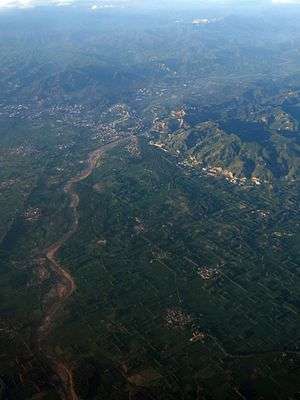Markanda River, Haryana
| Markanda River in Haryana | |
|---|---|
 | |
| Native name | मारकंडा नदी, हरियाणा |
| Country | India |
| Basin | |
| Main source | Shivalik Hills, Himachal Pradesh |
| Physical characteristics | |
| Discharge |
|
The Markanda river (Hindi: मारकंडा नदी) in the Haryana state of India is a tributary of Ghaggar river, flowing through Ambala district and Shahabad Markanda town in Kurukshetra district.[1][2]
Origin and route
The Markanda river is an eponymous seasonal river in Haryana state, which is a main tributary of the Ghaggar River.[3]
The Markanda river originates in the Shivalik hills on the border of Haryana and Himachal Pradesh State, and flows along the haryana and Punjab, India border before meeting with Ghaggar river at the confluence.[4]
The basin is classified in two parts, Khadir and Bangar, the higher area that is not flooded in rainy season is called Bangar and the lower flood-prone area is called Khadar.[4]
Identification with Vedic rivers
Several modern scholars identify the old Ghaggar-Hakra River (of which Tangri river is a tributary) as the Sarasvati river and the Chautang river with the Drishadvati river of Vedic period, on the banks of which Indus-Sarasvati civilisation developed. such scholars include Gregory Possehl,[5] J. M. Kenoyer,[6] Bridget and Raymond Allchin,[7] Michael Witzel,[8] Kenneth Kennedy,[9] Franklin Southworth,[10] and numerous Indian archaeologists.
Gregory Possehl and Jane McIntosh refer to the Ghaggar-Hakra river as "Sarasvati" throughout their respective 2002 and 2008 books on the Indus Civilisation.[11][12]
Gregory Possehl states:
"Linguistic, archaeological, and historical data show that the Sarasvati of the Vedas is the modern Ghaggar or Hakra."[12]
Gallery
 Indus-Sarasvati civilisation major sites
Indus-Sarasvati civilisation major sites
See also
- Dangri, a tributary of Sarsuti
- Tangri river, a tributary of Sarsuti, merge if Dangri and Tangri are same
- Sarsuti, a tributary of Ghaggar-Hakra River
- Kaushalya river, a tributary of Ghaggar-Hakra River
- Chautang, a tributary of Ghaggar-Hakra River
- Sutlej, a tributary of Indus
- Ganges
- Indus
- Western Yamuna Canal, branches off Yamuna
References
- ↑ AmbalaOnline - Rrvers of Ambala
- ↑ Indian Express - Ghaggar and Tangri rivers overflow
- ↑ Shanker Sharma, Hari; Kalwar, S. C. (2005). Geomorphology and Environmental Sustainability: Felicitation Volume in Honour of Professor H.S. Sharma. Concept Publishing Company. p. 61. ISBN 978-81-8069-028-0.
- 1 2 HaryanaOnline - Geography of Haryana
- ↑ Possehl, Gregory L. (December 1997), "The Transformation of the Indus Civilization", Journal of World Prehistory, 11 (4): 425–472, doi:10.1007/bf02220556, JSTOR 25801118
- ↑ Kenoyer, J. M. (1997), "Early City-states in South Asia: Comparing the Harappan Phase and the Early Historic Period", in D. L. Nichols; T. H. Charlton, The Archaeology of City States: Cross Cultural Approaches, Washington: Smithsonian Institution, pp. 52–70, ISBN 1560987227
- ↑ Allchin, Bridget; Allchin, Raymond (1982), The Rise of Civilization in India and Pakistan, Cambridge University Press, p. 160, ISBN 978-0-521-28550-6
- ↑ Erdosy 1995, pp. 105, 318.
- ↑ Erdosy 1995, p. 44.
- ↑ Erdosy 1995, p. 266.
- ↑ McIntosh, Jane (2008). The Ancient Indus Valley: New Perspectives. ABC-CLIO. ISBN 978-1-57607-907-2.
- 1 2 Gregory L. Possehl (2002). The Indus Civilization: A Contemporary Perspective. Rowman Altamira. p. 8. ISBN 978-0-7591-0172-2.
External links
| Wikimedia Commons has media related to Ghaggar-Hakra river. |
| Wikimedia Commons has media related to Sarasvati River. |
| Wikimedia Commons has media related to Indus Valley Civilization. |
| Wikimedia Commons has media related to Yamuna. |
| Wikimedia Commons has media related to Drishadvati river. |
- Sarasvati-Sindhu civilization and Sarasvati River
- The Saraswati: Where lies the mystery by Saswati Paik